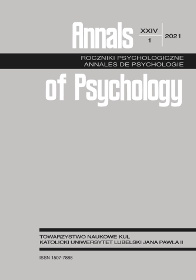Meeting Potential Parents-In-Law and Introducing a Partner to Own Parents: Prospective and Retrospective Studies
Abstract
Parents-in-law are an important part of adult relationships. Contact with them may affect satisfaction and marital success of a married couple. Previous research shows that amount of contact with in-laws, support given by them and conflicts with them have a significant impact on the life of a couple. Little research has explored relationships of parents and parents-in-law with a couple before marriage. Even less is known about the beginnings of these relationships. This research consists of two studies which explored the vision and memories of the first meetings of potential in-laws and parents as a couple. Study 1 (N1 = 34, age M = 23.40, SD = 2.32, Woman = 64.70% N1) asked the participants how they imagined those events, while evaluating stress accompanying them. The participants reported predictions of feeling stressed by both events, but also of excitement, having no expectations, being ashamed by their own parents or being trustful in parents’ behavior. Stress assessments of both events are inconclusive in establishing whether one of them is more stressful than the other. In Study 2 (N2 = 8, age M = 23.50, SD = 2.67, Woman = 62.50% N2) a sample of young adults was interviewed about their memories concerning situations of meeting their in-laws and introducing their partner to their own parents. The respondents recalled 37 features, of which experiencing stress and fear in both situations was common. All reflected on the way that the meeting happened and all but one described how they had prepared for it.
References
Apostolou, M. (2008). Parent–offspring conflict over mating: The case of beauty. Evolutionary Psychology, 6(2), 303–315. https://doi.org/10.1177/147470490800600207
Ayers, J., Krems, J., Hess, N., & Aktipis, A. (2020). Mother-in-law daughter-in-law conflict: An evolutionary perspective, ethnographic review, and report of empirical data from the United States. PsyArXiv. https://doi.org/10.31234/osf.io/uvcp4
Bancroft, J. (2011). Seksualność człowieka (R. Śmietana, Trans.). Elsevier Urban & Partner.
Blair, K. L., & Holmberg, D. (2008). Perceived social network support and well-being in same-sex versus mixed-sex romantic relationships. Journal of Social and Personal Relationships, 25(5), 769–791. https://doi.org/10.1177/0265407508096695
Bradford, A. B., Drean, L., Sandberg, J. G., & Johnson, L. N. (2020). They may disapprove, but I still love you: Attachment behaviors moderate the effect of social disapproval on marital relationship quality. Family Process, 59(4), 1–22. https://doi.org/10.1111/famp.12519
Chong, A., Gordon, A. E., & Don, B. P. (2017). Emotional support from parents and in-laws: The roles of gender and contact. Sex Roles, 76(5–6), 369–379. https://doi.org/10.1007/s11199-016-0587-0
Creswell, J. (2013). Research design: Qualitative, quantitative, and mixed methods approaches (4th ed.). Sage.
Erikson, E. (2004). Tożsamość a cykl życia (M. Żywicki, Trans.). Zysk i S-ka.
Fingerman, K. L., Gilligan, M., Vander Drift, L., & Pitzer, L. (2012). In-law relationships before and after marriage: Husbands, wives, and their mothers-in-law. Research in Human Development, 9(2), 106–125. https://doi.org/10.1080/15427609.2012.680843
Fowler, C., & Rittenour, C. (2017). A life-span approach to children-in-law’s perceptions of parent-in-law communication. Journal of Family Communication, 17(3), 254–272. https://doi.org/10.1080/15267431.2017.1281280
Halley, J. (1973). Uncommon Therapy. W. W. Norton.
Havighurst, R. J. (1981). Developmental tasks and education. Longman.
Hornowska, E. (2001). Testy psychologiczne: teoria i praktyka. Scholar.
Horsley, G. C. (1997). In-laws: Extended family therapy. American Journal of Family Therapy, 25(1), 18–27. https://doi.org/10.1080/01926189708251051
Kołbik, I. (1999a). Procesy emocjonalne w rodzinie [Emotional processes in the family]. In B. de Barbaro (Ed.), Wprowadzenie do systemowego rozumienia rodziny [Introduction to the systemic understanding of the family] (pp. 31–44). Wydawnictwo Naukowe Uniwersytetu Jagiellońskiego.
Kołbik, I. (1999b). Lojalność rodzinna [Loyality in the family]. In B. de Barbaro (Ed.), Wprowadzenie do systemowego rozumienia rodziny [Introduction to the systemic understanding of the family] (pp. 78–84). Wydawnictwo Naukowe Uniwersytetu Jagiellońskiego.
Lawshe, C. H. (1975). A quantitative approach to content validity. Personnel Psychology, 28, 563–575.
Lee, J. E., Kim, K., Cichy, K. E., & Fingerman, K. L. (2020). Middle-aged children’s support for parentsin-law and marital satisfaction. Gerontology, 66(4), 340–350. https://doi.org/10.1159/000505589
Levinson, D. J. (1988). The seasons of a man’s life. Alfred A. Knopf.
Lind Seal, K., Doherty, W. J., & Harris, S. M. (2016). Confiding about problems in marriage and longterm committed relationships: A national study. Journal of Marital and Family Therapy, 42(3), 438–450. https://doi.org/10.1111/jmft.12134
Ostoja-Zawadzka, K. (1999). Cykl życia rodzinnego [The cycle of family life]. In B. de Barbaro (Ed.), Wprowadzenie do systemowego rozumienia rodziny [Introduction to the systemic understanding of the family] (pp. 18–30). Wydawnictwo Naukowe Uniwersytetu Jagiellońskiego.
Perilloux, C., Fleischman, D. S., & Buss, D. M. (2011). Meet the parents: Parent–offspring convergence and divergence in mate preferences. Personality and Individual Differences, 50(2), 253–258. https://doi.org/10.1016/j.paid.2010.09.039
Prentice, C. M. (2008). The assimilation of in-laws: The impact of newcomers on the communication routines of families. Journal of Applied Communication Research, 36(1), 74–97. https://doi.org/10.1080/00909880701799311
Reczek, C., Liu, H., & Umberson, D. (2010). Just the two of us? How parents influence adult children’s marital quality. Journal of Marriage and Family, 72(5), 1205–1219. https://doi.org/10.1111/j.1741-3737.2010.00759.x
Rodrigues, D., Lopes, D., Monteiro, L., & Prada, M. (2017). Perceived parent and friend support for romantic relationships in emerging adults. Personal Relationships, 24(1), 4–16. https://doi.org/10.1111/pere.12163
Rozkrut, D. (Ed.) (2018). Rocznik Statystyczny [Statistical Yearbook]. Główny Urząd Statystyczny. Santos, J. D., & Levitt, M. J. (2007). Intergenerational relations with in-laws in the context of the social convoy: Theoretical and practical implications. Journal of Social Issues, 63(4), 827–843. https://doi.org/10.1111/j.1540-4560.2007.00539.x
Serewicz, M. C. M., Hosmer, R., Ballard, R. L., & Griffin, R. A. (2008). Disclosure from in-laws and the quality of in-law and marital relationships. International Journal of Phytoremediation, 56(4), 427–444. https://doi.org/10.1080/01463370802453642
Silverstein, J. L. (1992). The problem with in-laws. Journal of Family Therapy, 14(4), 399–412. https://doi.org/10.1046/j..1992.00469.x
Sobolewski, A., Strelau, J., & Zawadzki, B. (1999). Kwestionariusz Zmian Życiowych (KZŻ): Polska adaptacja kwestionariusza “Recent Life Changes Questionnaire” (RLCQ) R. H. Rahe’a. Przegląd Psychologiczny, 42(3), 27–49.
Turner, M. J., Young, C. R., & Black, K. I. (2006). Daughters-in-law and mothers-in-law seeking their place within the family: A qualitative study of differing viewpoints. Family Relations, 55(5), 588–600. https://doi.org/10.1111/j.1741-3729.2006.00428.x
Copyright (c) 2021 Roczniki Psychologiczne

This work is licensed under a Creative Commons Attribution-NonCommercial-NoDerivatives 4.0 International License.


